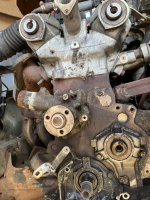Whenever I'm trying to see something clearly, I find it helpful to clean what I'm trying to see

e.g.
View attachment 443256
I can see an angled alignment mark (which I've highlighted in red) on the aluminum cover behind the crank cog that seems to me to align with both the crank cog and possibly the auxiliary drive cog? (I'm aware that on the older Fiat T/C engines this auxiliary drive cog had to be set at 34* (approx 4 teeth) clockwise from the vertical position, but I'm not very familiar with the 2 litre engine).
Now as regards ignition timing marks, I reckon that if the bent pointer bracket were to be straightened (preferably in a vise, not on the engine), the 3 points might align with the notch (highlighted in red) on the inner ring of your crank pulley (reverse side shown in your 2nd pic). Maybe try it and see?
I wonder how this pointer bracket became bent - maybe someone bent it out of the way to change a drive belt?
View attachment 443257
If this notch does align with the pointer bracket then the 3 points likely indicate 10*btdc, 5*btdc and TDC (going from left to right), so can be used for ignition timing checks as well as valve timing checks. Be aware that rotating the auxiliary drive cog/belt pulley also rotates the distributor drive shaft thereby changing the ignition timing, so this will have to be checked/reset before trying to start the engine. (might not have been correct originally)
P.S. I also have
vague memories that when
all the valve timing marks are aligned, the distributor rotor should actually point at no 4 cyl. on the distributor cap, not at no.1 cyl. as is usual. But I could be wrong (wouldn't be the first time).


